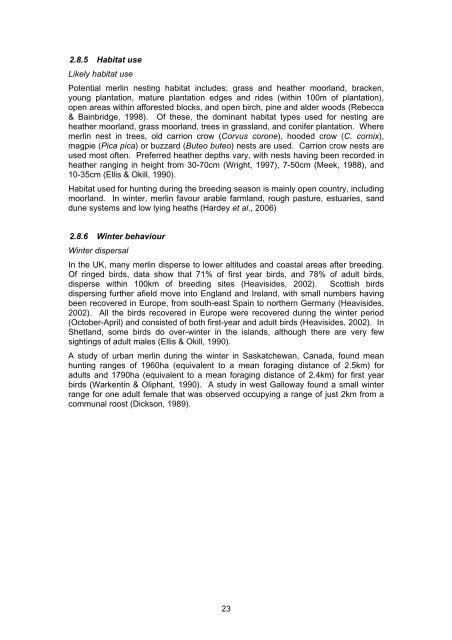Literature review to assess bird species connectivity to Special ...
Literature review to assess bird species connectivity to Special ...
Literature review to assess bird species connectivity to Special ...
You also want an ePaper? Increase the reach of your titles
YUMPU automatically turns print PDFs into web optimized ePapers that Google loves.
2.8.5 Habitat use<br />
Likely habitat use<br />
Potential merlin nesting habitat includes: grass and heather moorland, bracken,<br />
young plantation, mature plantation edges and rides (within 100m of plantation),<br />
open areas within afforested blocks, and open birch, pine and alder woods (Rebecca<br />
& Bainbridge, 1998). Of these, the dominant habitat types used for nesting are<br />
heather moorland, grass moorland, trees in grassland, and conifer plantation. Where<br />
merlin nest in trees, old carrion crow (Corvus corone), hooded crow (C. cornix),<br />
magpie (Pica pica) or buzzard (Buteo buteo) nests are used. Carrion crow nests are<br />
used most often. Preferred heather depths vary, with nests having been recorded in<br />
heather ranging in height from 30-70cm (Wright, 1997), 7-50cm (Meek, 1988), and<br />
10-35cm (Ellis & Okill, 1990).<br />
Habitat used for hunting during the breeding season is mainly open country, including<br />
moorland. In winter, merlin favour arable farmland, rough pasture, estuaries, sand<br />
dune systems and low lying heaths (Hardey et al., 2006)<br />
2.8.6 Winter behaviour<br />
Winter dispersal<br />
In the UK, many merlin disperse <strong>to</strong> lower altitudes and coastal areas after breeding.<br />
Of ringed <strong>bird</strong>s, data show that 71% of first year <strong>bird</strong>s, and 78% of adult <strong>bird</strong>s,<br />
disperse within 100km of breeding sites (Heavisides, 2002). Scottish <strong>bird</strong>s<br />
dispersing further afield move in<strong>to</strong> England and Ireland, with small numbers having<br />
been recovered in Europe, from south-east Spain <strong>to</strong> northern Germany (Heavisides,<br />
2002). All the <strong>bird</strong>s recovered in Europe were recovered during the winter period<br />
(Oc<strong>to</strong>ber-April) and consisted of both first-year and adult <strong>bird</strong>s (Heavisides, 2002). In<br />
Shetland, some <strong>bird</strong>s do over-winter in the islands, although there are very few<br />
sightings of adult males (Ellis & Okill, 1990).<br />
A study of urban merlin during the winter in Saskatchewan, Canada, found mean<br />
hunting ranges of 1960ha (equivalent <strong>to</strong> a mean foraging distance of 2.5km) for<br />
adults and 1790ha (equivalent <strong>to</strong> a mean foraging distance of 2.4km) for first year<br />
<strong>bird</strong>s (Warkentin & Oliphant, 1990). A study in west Galloway found a small winter<br />
range for one adult female that was observed occupying a range of just 2km from a<br />
communal roost (Dickson, 1989).<br />
23

















